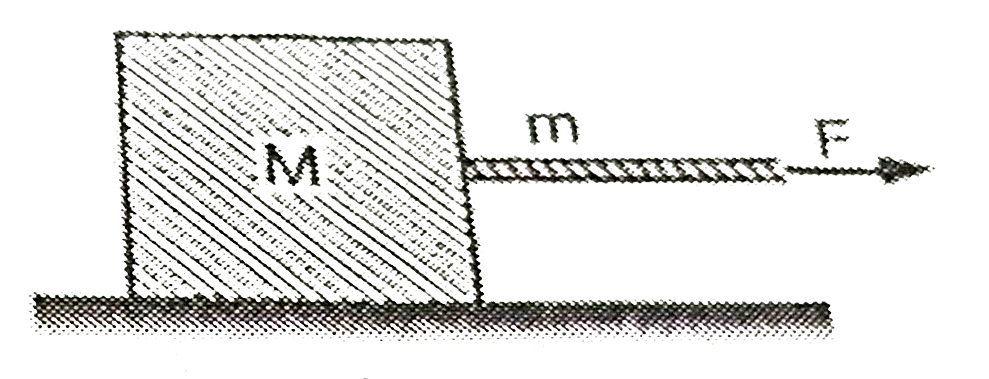A 10kg body is suspended by a rope is pulled by means of a horizontal force to make 60∘ by rope to vertical.The horizontal forces is
10kgwt
30kgwt
10√3kgwt
30√3kgwt
The correct Answer is:C
To solve the problem of a 10 kg body suspended by a rope that makes an angle of 60 degrees with the vertical when pulled by a horizontal force, we can follow these steps:
Step 1: Understand the Forces Acting on the Body
The body has two main forces acting on it:
1. The weight of the body (W = mg), acting downwards.
2. The tension (T) in the rope, which has two components:
- A vertical component (T cos(θ)) that balances the weight of the body.
- A horizontal component (T sin(θ)) that is balanced by the horizontal force (F).
Step 2: Calculate the Weight of the Body
The weight of the body can be calculated using the formula:
W=mg
Where:
- m=10kg
- g≈9.81m/s2
Calculating the weight:
W=10×9.81=98.1N
Step 3: Set Up the Equations
From the forces acting on the body, we can set up the following equations based on the components of tension:
1. Vertical component:
Tcos(60∘)=mg
2. Horizontal component:
Tsin(60∘)=F
Step 4: Substitute the Known Values
Using cos(60∘)=0.5 and sin(60∘)=√32:
1. From the vertical component:
T⋅0.5=98.1
T=98.10.5=196.2N
2. From the horizontal component:
F=T⋅sin(60∘)=196.2⋅√32
Step 5: Calculate the Horizontal Force
Now substituting the value of T into the horizontal force equation:
F=196.2⋅√32
F=98.1√3
Step 6: Final Calculation
To find the numerical value of F:
Using √3≈1.732:
F≈98.1⋅1.732≈170.0N
Final Answer
The horizontal force F required to maintain the body at an angle of 60 degrees with the vertical is approximately 170.0 N.
---
The body has two main forces acting on it:
1. The weight of the body (W = mg), acting downwards.
2. The tension (T) in the rope, which has two components:
- A vertical component (T cos(θ)) that balances the weight of the body.
- A horizontal component (T sin(θ)) that is balanced by the horizontal force (F).
The weight of the body can be calculated using the formula:
W=mg
Where:
- m=10kg
- g≈9.81m/s2
W=10×9.81=98.1N
From the forces acting on the body, we can set up the following equations based on the components of tension:
1. Vertical component:
Tcos(60∘)=mg
2. Horizontal component:
Tsin(60∘)=F
Using cos(60∘)=0.5 and sin(60∘)=√32:
1. From the vertical component:
T⋅0.5=98.1
T=98.10.5=196.2N
F=T⋅sin(60∘)=196.2⋅√32
Now substituting the value of T into the horizontal force equation:
F=196.2⋅√32
F=98.1√3
To find the numerical value of F:
Using √3≈1.732:
F≈98.1⋅1.732≈170.0N
The horizontal force F required to maintain the body at an angle of 60 degrees with the vertical is approximately 170.0 N.
Topper's Solved these Questions
- BOOK - NARAYNACHAPTER - MOTION IN A PLANEEXERCISE - Level-II(C.W)45videos
MOTION IN A PLANE
- BOOK - NARAYNACHAPTER - MOTION IN A PLANEEXERCISE - Level-III(C.W)48videos
MOTION IN A PLANE
- BOOK - NARAYNACHAPTER - MOTION IN A PLANEEXERCISE - C.U.Q36videos
MOTION IN A PLANE
- BOOK - NARAYNACHAPTER - MECHANICAL PROPERTIES OF SOLIDSEXERCISE - LEVEL-II (H.W)24videos
MECHANICAL PROPERTIES OF SOLIDS
- BOOK - NARAYNACHAPTER - MOTION IN A STRAIGHT LINEEXERCISE - Level 2 H.W29videos
MOTION IN A STRAIGHT LINE
Similar Questions
Knowledge Check
- Question 1 - Select One
A mass of 10 kg is suspended from a spring balance, it is pulled aside by a horizontal string so that it makes an angle 60∘ with the vertical. The new reading of the balance is:
A10√3 kg wtB20√3 kg wtC20 kg wtD10 kg wt - Question 2 - Select One
An iron sphere of mass 100kg is suspended freely from a rigid support by means of a rope of length 2m.The horizontal force required to displace it horizontally through 50cm is nearly
A980NB490NC245ND112.5N - Question 3 - Select One
A mass of 10 kg is suspended from a spring balance. It is pulled aside by a horizontal string so that it makes an angle of 60∘ with the vertical. The new rading of the balance is
A20 kg-wtB10 kg-wtC10√3 kg-wtD20√3 kg-wt
A mass M is suspended by a weightless string The horizontal force required to hold the mass 60∘ with the vertical is .
View SolutionA mass of 10 kg is suspended vertically by a rope from the roof. When a horizontal force is applied on the rope at some point, the rope deviated at an angle of 45∘ at the roof point. If the suspended mass is at equilibrium, the magnitude of the force applied is (g=10ms−2)
View SolutionA block of mass M is pulled along a horizontal frictionless surface by a rope of mass m as shown in A horizontal force F is applied to one end of the rope. Find
(a) the acceleration of the rope and block
(b) the force that the rope exerts on the block
(c) the tension in the rope at its mid point
 View Solution
View SolutionA block of mass M is pulled along a horizontal frictionless surface by a rope of mass m, as shown in Fig. 5-35. A horizontal force acts on one end of the rope.

(a) Show that the rope must sag, even if only by an imperceptible amount.
(b) Then, assuming that the sag is negligible, find the acceleration of rope and block.
(c) Find the force on the block from the rope.
(d) Find the tension in the rope at its midpoint.View SolutionA weight w is suspended from the midpoint of a rope, whose ends are at the same level. In order to make the rope perfectly horizontal, the force applied to each of its ends must be
View Solution

